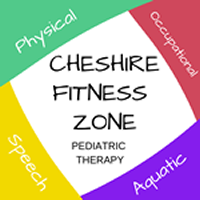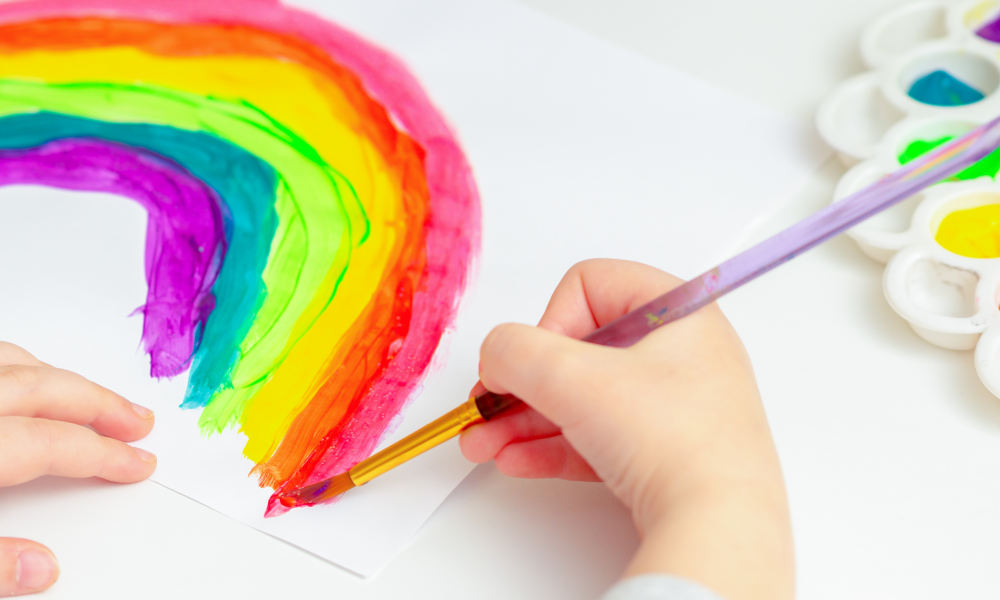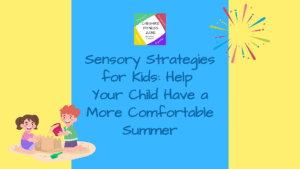Back-to-School Confidence Through Creativity
As kids transition back to school, parents and caregivers are preparing for a new academic year filled with challenges and opportunities. It is important to have creative outlets for kids to help reduce their stress. Integrating art and creative exercises into their routine can provide a wonderful and supportive way to enhance their development and emotional well-being.
In this blog post, we’ll explore how art and creative exercises can add to your child’s therapeutic journey during the back-to-school transition.
Art Therapy Activities
Art therapy allows children to express themselves through drawing, painting, and other creative mediums. It can help them explore and communicate their thoughts and feelings in a safe and non-verbal way.
Painting Emotions
Encourage your child to paint or draw their emotions using colors and shapes to represent different feelings.
Children can be guided to create artwork that represents their emotions. For example, they might use different colors and shapes to illustrate feelings like happiness, sadness, or anger.
Create a Feelings Collage
Cut out pictures from magazines that depict various emotions and create a collage to discuss and express emotions.
Creating collages with images and words from magazines or other materials can help children explore and communicate their thoughts and experiences. This activity encourages creativity and self-reflection.
Storytelling Through Art
Have your child create a series of drawings that tell a story or represent a personal experience.
Children may be encouraged to create a series of drawings or paintings that tell a story. This can help them process past events, explore their imaginations, or express their hopes and dreams.
Play Therapy Activities
Play therapy is especially beneficial for younger children. Through play, children can work through emotional and behavioral issues while having fun. This can include using toys, games, and storytelling to address specific concerns.
Puppet Play
Use puppets or stuffed animals to act out scenarios or discuss feelings. This can help children express themselves in a less intimidating way.
Using puppets or dolls, children can act out scenarios, express emotions, and engage in dialogue. This form of play helps them externalize their feelings and explore various roles.
Sand Tray Therapy
Provide a tray of sand and miniature toys, dolls, and figures for your child to create scenes that represent their thoughts and emotions.
Children use miniature figures, objects, and sand in a tray to create scenes that represent their thoughts, feelings, and experiences. This hands-on activity can reveal insights into their inner world.
Game-Based Therapy
Play board games or card games that encourage communication, cooperation, and problem-solving.
Music Therapy Activities
Music therapy utilizes the therapeutic power of music to promote emotional expression, improve communication, and enhance cognitive skills. Singing, playing instruments, and rhythmic activities can be a part of this therapy.
Music Relaxation
Listen to calming music together to help your child manage stress and anxiety.
Singing and Songwriting
Encourage your child to write and sing songs about their experiences or emotions. Listen to various sounding songs, and explain how different sounds can make you feel different types of emotions.
You can help a child craft original songs to express their thoughts and emotions in a structured and artistic way. They may write lyrics based on their experiences.
Instrument Play
Children can explore various musical instruments, such as xylophones or keyboards. This hands-on experience encourages self-expression and creativity
Rhythm-based exercises, such as drum circles or clapping games, help children develop coordination, improve focus, and engage in rhythmic self-expression.
Dance/Movement Therapy Activities
Dance and movement therapy help children express themselves through body movement. It can enhance self-esteem, body awareness, and emotional regulation.
Children are naturally creative beings, and harnessing their creativity can be a powerful tool. Art and creative activities encompass a variety of techniques that use artistic expression to help children communicate, process emotions, and build essential skills.
Freeform Dance
Put on some music and let your child move freely without structured steps or routines.
When kids move their bodies freely to music without choreography, it allows them to express emotions and creativity through movement.
Yoga for Kids
Explore kid-friendly yoga poses and stretches to promote physical and emotional well-being.
Yoga helps teach kids self control and patience, while helping them regulate emotion and reduce their stress.
Expressive Movement
Encourage your child to use movement to express specific emotions, such as joy, sadness, or anger.
Model and explain what different emotions would look like through movement and dance.
How Creative Activities Enhance Back-to-School Transition
Building Confidence
A confident child is more likely to approach the new school year with enthusiasm and a belief in their abilities. They are better equipped to face academic challenges, engage with classmates, and seek help when needed. Engaging in creative activities can boost a child’s self-esteem and confidence in several ways.
Self-Expression
Creative activities provide a platform for children to express themselves without fear of judgment. When children see their ideas and emotions take shape in their artwork, stories, or music, it bolsters their sense of accomplishment
Problem-Solving
Creative exercises often involve making decisions and solving challenges. When children successfully navigate these tasks, they gain a sense of competence that carries over to other areas of their lives, including academics.
Peer Recognition
Sharing creative work with peers or in groups can lead to positive feedback and peer recognition, further boosting a child’s self-worth.
Improving Communication
Creative exercises encourage children to communicate and express their thoughts and emotions in various ways. Improved communication skills can help children express their needs, concerns, and ideas more effectively in the classroom. They can collaborate with teachers and peers, seek help when necessary, and participate more actively in class discussions.
Non-Verbal Expression
For children who may have different communication preferences, creative activities offer an alternative means of expression. Art, play, and music can provide additional avenues for communication.
Active Listening
Engaging in creative activities often involves listening to others, whether it’s a parent or peers in a group setting. This enhances a child’s listening skills, which are crucial for effective communication.
Stress Reduction
The ability to manage stress effectively is crucial for children facing the challenges of a new school year. Creative therapies equip them with coping mechanisms that can be applied when dealing with academic pressure or social stressors
Emotional Release
Engaging in creative activities can serve as a healthy outlet for pent-up emotions, reducing stress and anxiety.
Mindfulness and Relaxation
Some creative exercises, such as deep breathing during art creation or rhythmic movements in dance therapy, promote relaxation and mindfulness, helping children manage stress.
Positive Distraction
Creative activities divert a child’s focus away from stressors, allowing them to immerse themselves in a positive and enjoyable experience.
Social Skills Development
Children who have improved social skills are better equipped to make friends, build positive relationships with teachers, and handle social situations effectively, which contributes to a smoother transition into the school environment.
Teamwork
Collaborating on a creative project with peers teaches children how to work as a team, share ideas, and compromise.
Empathy
Engaging with the emotions expressed by others in a therapeutic context fosters empathy and understanding.
Conflict Resolution
Creative group activities offer opportunities to practice conflict resolution, which is valuable in navigating social interactions.
Getting Started with Creative Exercises
If you believe that your child could benefit from creative therapeutic activities as they head back to school, consider the following steps:
Consult a Pediatric Therapist
Begin by discussing your child’s needs and concerns with a qualified pediatric therapist. They can assess your child’s specific needs and recommend the most appropriate creative therapeutic activities.
Explore Therapeutic Options and Local Programs
Depending on the therapist’s recommendations, explore art therapy, play therapy, music therapy, or dance/movement therapy programs in your area.
Cheshire Fitness Zone offers our very own programs throughout the year!
Speech-Language Pathologist Lauren Brickett runs the Speech, Music, Movement program which uses music and movement to help kids use music as a source of expression.
Occupational Therapists Morgan Salerno and Bianca Lane created the Move & Groove Social Group that kicks off mid September, that uses movement and sensory play to help increase social skills.
Follow us on Facebook and Instagram to look out for updates of new and upcoming programs!
Establish a Routine
Incorporate creative therapies into your child’s weekly routine to ensure consistency and maximize the therapeutic benefits. Explore different activities after school to help the child both unwind and communicate about their day.
Encourage Open Communication
Foster an environment where your child feels comfortable sharing their experiences in therapy. This can lead to more effective outcomes.
Engaging in frequent activities with them will make them feel more comfortable about communicating openly with their caregiver.
Support Emotional Growth Through Creativity
Back-to-school season is an exciting time for children, and creative exercises can empower them to navigate this transition with confidence. By embracing the power of creativity, you can support your child’s emotional growth and overall well-being, making the school year ahead a truly enriching experience.
Incorporating creative activities into a child’s routine, especially before heading back to school, can have far-reaching benefits. These activities empower children to build confidence, communicate effectively, manage stress, and develop crucial social skills, ultimately setting them up for success in the classroom and beyond.



